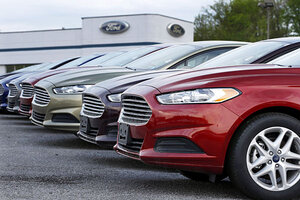Should you buy a used car or a new car?
When it comes to cars, used vehicles are much kinder to your wallet. Make sure you get a vehicle history report and a mechanic's thumbs up before purchasing the car, and you should be on your way to saving thousands of dollars, Hamm says.

A row of new 2013 Ford Fusions is displayed at an automobile dealership in Zelienople, Pa. last month. Newer cars may be more appealing to buyers, but Hamm says used cars can save drivers thousands of dollars.
Keith Srakocic/AP/File
The best way to maximize your value from a car, regardless of when you buy it, is to drive it until the problems become overwhelming, then trade it in for whatever value you can get out of it. I consider that the first rule of frugal car buying.
The tough question is whether or not it makes sense to buy a new car or a used one. With the new car, you’re going to be able to drive it for longer, but with a used car, the price is so much lower. What’s the right choice?
Lots of personal finance guides make the absolute assumption that doing anything other than buying a car used is a very foolish move.
Is that a true statement? It’s worth digging in a bit to find out.
First of all, what are the relative purchase costs of similar used cars? I used Kelley’s Blue Book to get estimates on the prices for an entry-level Toyota Corolla in my area.
A new 2013 Toyota Corolla will cost you $15,530.
A 2008 Toyota Corolla with 75,000 miles on it and in excellent shape will cost you $10,838.
A 2003 Toyota Corolla with 150,000 miles on it and in excellent shape will cost you $6,195.
The question really becomes how reliable each of these cars are. For each one, you’d want to check out a vehicle history report and have a mechanic look at them. If they’ve been well-maintained, I would estimate you’d get to 200,000 miles with the new one, 225,000 with the medium one, and 250,000 with the old one. That’s because a perfectly maintained car that’s in excellent shape will always have significant life after you buy it, as the “lemon” issues have been weeded out. This also assumes, of course, that you continue the maintenance.
Thus, with the new car, you’re paying $15,530 for 200,000 miles, or $0.08 per mile. With the medium car, you’re paying $10,838 for 150,000 miles, or $0.07 per mile. With the old car, you’re paying $6,195 for 100,000 miles, or $0.06 per mile.
Per mile, the older car is cheaper. Note that this is just a general trend, and that Edmunds, for example, reports that some new cars are a better bargain, though the models are few and far between.
However, the math doesn’t end there.
Insurance is a huge concern. If you’re comparing insurance quotes among models of the same car but with different ages, you’re going to find that the newer models have a higher insurance cost than the older models. That’s because the value of the older models is lower, thus the actual amount you’re insuring is lower, too.
As always, it pays to shop around for auto insurance and know what you’re buying. The Simple Dollar has a great car insurance guide that’s well worth investigating if you’re in the market for auto insurance.
There’s also the interest question. If you’re taking out a car loan for that new car, then you’re essentially adding to the cost of that car, tipping the scales even more toward the used car. Even if you have to get a loan for the used car, it’s going to be a substantially smaller loan with substantially less interest paid by you.
When you add up all of these factors, a well-maintained used vehicle is clearly the best option for your dollar. Sure, you’ll reach the point of needing a replacement faster than you would with a new car, but you’re saving far more along the way.


